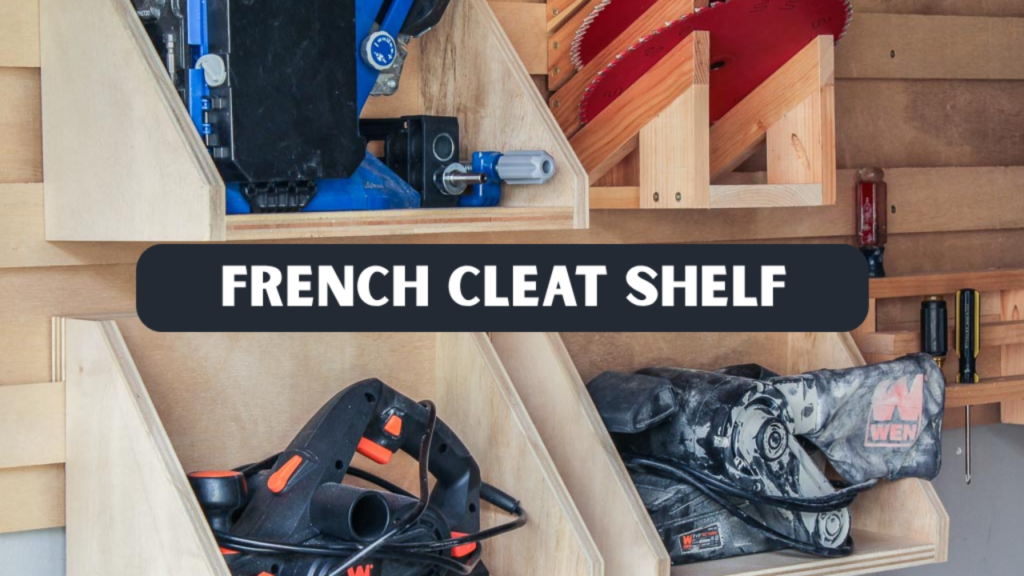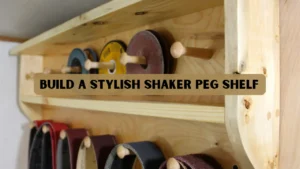Key Takeaways
- A French cleat shelf is a durable, removable, and adjustable wall-mount system ideal for workshops, garages, and home storage.
- Properly cut 45° cleats, secure one cleat into wall studs, and attach the mating cleat to the shelf for a rock-solid hold.
- Use quality materials such as plywood or hardwood and the right fasteners to support heavy tools; always test the load gradually.
- Variations include heavy-duty cleats for power tools, multi-shelf systems, floating designs, and compact tool organizers.
Getting Started with Your French Cleat Shelf
A French cleat shelf system is a highly practical and versatile addition to any workshop. It provides strong, reliable support for tools and accessories while keeping your space organized and efficient. With a few simple techniques, you can customize it to fit your specific needs. Its flexibility makes it suitable for a wide range of woodworking projects.
This guide offers step-by-step instructions and real-world advice from experienced woodworkers. You will learn how to measure, cut, and install a cleat system that is both secure and adjustable. By following these methods, your shelf will withstand daily use and heavy loads. The result is a long-lasting and adaptable storage solution for your workshop.
Why Choose a French Cleat System
A French cleat shelf combines simplicity with high load capacity. The mating 45-degree cleats provide a long contact area that distributes weight and resists shear, making them perfect for heavy or frequently rearranged setups.
Benefits at a glance:
- Strong and secure, with wide surface contact and solid fasteners.
- Easily adjustable and removable for flexibility.
- Low-profile wall system that saves space.
- Customizable with wood types, finishes, and shelf dimensions.
This makes them ideal for Lathes style workshops where space around lathes and benches requires clever and sturdy organization.
Tools and Materials Needed
Tools:
- Table saw or circular saw with a guide
- Drill and set of bits
- Level and measuring tape
- Stud finder
- Clamps
- Sandpaper or orbital sander
- Countersink bit
Materials:
- 3/4 inch plywood or hardwood for cleats and shelves
- 1 1/4 to 2 1/2 inch wood screws rated for stud fastening
- Wood glue (optional for shelf assembly)
- Wall anchors (for partial stud coverage)
- Finish such as polyurethane, oil, or paint
Optional upgrades:
- Metal cleats for heavy-duty installations
- Toggle bolts or concrete anchors for non-stud walls
- Edge banding for a finished look
Planning and Measuring
Planning is crucial. Before cutting or fastening, measure your wall area and determine the expected load.
Planning checklist:
- Mark stud locations using a stud finder. Ensure each stud is secure before proceeding.
- Choose cleat length to ensure adequate load distribution. Longer cleats spread weight more evenly.
- Consider multiple cleat pairs for longer or heavier shelves. This provides extra support and stability.
- Allow clearance for tools and objects above and below the shelf. Measure carefully to avoid interference.
Pro Tip: For heavier loads, anchor into at least two studs and use a cleat that spans both.
Step by Step Process
Step 1: Cut the Cleats
- Rip a 3–4 inch strip from 3/4 inch plywood or hardwood using a table saw.
- Set the blade to 45 degrees and cut the strip into two matching pieces so the mating faces align perfectly.
- One piece will mount to the wall, and the other will attach to the shelf.
Tip: Make two passes for smoother cuts and sand the surfaces lightly.
Step 2: Prepare the Shelf Backing
- Attach the shelf cleat securely across the back of the shelf.
- If using a plywood box design, glue and screw a cleat to the inside back panel for a cleaner appearance.
Common approaches:
- Face-mounted cleat: visible but quick to install.
- Recessed cleat: clean look, requires routing.
- Continuous cleat: offers maximum load distribution.
Step 3: Mount the Wall Cleat
- Locate studs and pre-drill holes.
- Secure the wall cleat using long screws directly into studs or heavy-duty anchors.
- Confirm with a level that it’s perfectly straight.
Safety Note: For concrete or brick walls, use proper masonry anchors rated for your shelf load.
Step 4: Hang the Shelf
- Lift the shelf and engage the 45-degree cleat angles.
- Ensure it locks tightly into place.
- Add a small screw or safety pin underneath for additional security.
Step 5: Test the Load
- Gradually add weight to ensure proper holding power.
- Observe any movement or loosening and tighten screws as needed.
Pro Tip: Mark the anchor positions on a workshop wall diagram for future reference.
Design Variations and Creative Uses
Workshop ideas:
- Tool-holding French cleat panels with modular tool holders. They make organizing hand tools quick and efficient.
- Heavy-duty platforms for power tools and chargers. These provide strong, reliable support for heavy equipment.
- Lathe accessory shelves for chisels and oils. Perfect for keeping lathe tools and supplies within easy reach.
Home and décor ideas:
- Floating wall shelves with hidden cleats. These offer a clean, modern look while remaining sturdy.
- Adjustable art display walls. They allow for easy rearrangement of artwork without extra hardware.
- Entryway coat racks using vertical cleats. Perfect for hanging coats and bags while saving floor space.
Comparing Plywood, Hardwood, and Metal Cleats
- Plywood: Affordable and strong. It is also dimensionally stable for workshop use.
- Hardwood: Durable and attractive. Ideal for shelves that will be visible or decorative.
- Metal: Best for high-load applications. Suitable for commercial or heavy-duty shelving.
Recommendation: Hardwood-faced plywood is ideal for balance and appearance.
Troubleshooting and Common Mistakes
- Uneven cuts cause shelf wobble. Re-cut or sand as needed for stability.
- Failing to anchor into studs reduces strength. Always use proper anchors for safety.
- Using too short cleats increases stress. Span at least two studs to distribute weight.
- Ignoring level alignment makes shelves appear crooked. Always check with a level before final mounting.
Real-World Example and Experience
A six-foot French cleat shelf was installed over a lathe area. The builder used a continuous plywood cleat secured into two studs, with a clear polyurethane finish. After storing chisels, gauges, and power drivers, the system remained stable after months of daily use.
Lessons learned:
- Always anchor into multiple studs.
- Use oil-based finishes in humid conditions.
- Test loads progressively.
This hands-on experience shows that a properly built French cleat can outperform traditional brackets in both strength and flexibility..
Maintenance and Longevity
- Inspect the cleats every six months to ensure stability. Always check for any signs of wear.
- Retighten screws and check wall anchors for wear. Make sure all fasteners remain secure.
- Sand and refinish exposed wood periodically to maintain a clean finish. This also protects the wood from damage.
- Avoid overloading beyond tested weight limits to prevent accidents. Always distribute weight evenly across the cleat.
For added safety, use a secondary pin or bracket for heavy tools.
Conclusion
A French cleat shelf is an essential addition for any woodworking enthusiast. Using precise cuts and durable materials, you can build a wall-mounted system that optimizes space. The adjustable design allows for easy repositioning of shelves to fit changing storage needs. It keeps your workshop or home organized and efficient.
With careful installation, the French cleat system provides reliable support for tools and equipment. Its modular structure adapts to different uses and locations within your workspace. Heavy items can be hung securely without risk of sagging or instability. This solution combines strength, flexibility, and long-term durability for your projects.
Frequently Asked Questions
What angle should a French cleat be cut?
A 45-degree angle is standard because it creates a secure interlock. Some woodworkers adjust between 30 and 60 degrees for specific wall clearances or aesthetics.
Can I use MDF for a cleat shelf?
MDF is suitable only for light loads. It lacks screw-holding strength compared to plywood or hardwood. Always prefer plywood for workshop shelving.
How much weight can a French cleat support?
A properly installed 3/4 inch plywood cleat anchored into studs can hold over 100 pounds, depending on fasteners and wall type. For safety, test gradually and distribute loads evenly.
What is the best wall type for French cleat installation?
Wood-framed walls with accessible studs provide the best strength. For concrete, use heavy-duty anchors like sleeves or expansion bolts.
Can French cleat shelves be used outdoors?
Yes, but use weather-resistant wood, stainless fasteners, and exterior finishes to prevent moisture damage.




